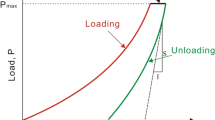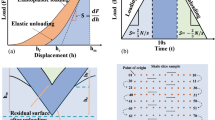Abstract
Quantitative characterization of the heterogeneity of shale mineral particles and determination of the relationship between the heterogeneity and the anisotropy of shale meso-mechanical behavior is difficult. Based on the Advanced Mineral Identification and Characterization System (AMICS) mineral analysis system, the distribution of shale minerals grain has been obtained. The coordinate population variance and heterogeneity coefficient are innovatively proposed to quantitatively characterize the directional arrangement characteristics of shale particles. The anisotropic mesoscopic failure characteristics of shale with different burial depths in the Longmaxi formation, Southern Sichuan, China, were obtained by X-ray nano-CT (computed tomography) real-time monitoring, and the relationship between shale mineral grain arrangement and meso-mechanical behavior is discussed. The results show that both coefficients defined in this study can reflect the anisotropic distribution of mineral particles, and assist in finding the direction of mineral particle deposition. Based on the calculation of two parameters, we found that the studied shale from three different depths have different mineral grain distributions along the bedding orientation, which controls the fracture evolution characteristics and the macroscopic mechanical behavior of the vertical bedding of shale. Fracture propagation of the horizontal bedding shale is related to micro-cracks. Micro-cracks are usually developed in the periphery of high-density brittle minerals, and cracks under external loadings are generated by the expansion of these micro-cracks.














Similar content being viewed by others
References
Brittany NH, Joseph JD (2018) Quantitative mineralogy for facies definition in the Marcellus shale (Appalachian Basin, USA) using XRD-XRF integration. Sediment Geool 371:16–31
Chen S, Zhu Y, Wang H, Liu H, Wei W, Fang J (2011) Shale gas reservoir characterization: a typical case in the southern Sichuan Basin of China. Energy 36(11):6609–6616
Chen J, Lan H, Macciotta R, Martin CD, Wu Y (2021) Microfracture characterization of shale constrained by mineralogy and bedding. J Petrol Sci Eng 201:108456
Cobbold PR, Zanella A, Rodrigues N, Løseth H (2013) Bedding-parallel fibrous veins (beef and cone-in-cone): Worldwide occurrence and possible significance in terms of fluid overpressure, hydrocarbon generation and mineralization. Mar Pet Geol 43:1–20
Du S, Shi Y, Zheng X, Chai G (2020) Using “Umbrella Deconstruction & Energy Dispersive Spectrometer(UD-EDS)” technique to quantify the anisotropic elements distribution of “Chang 7” shale and its significance. Energy 191:116443
Fjær E, Nes O (2014) The impact of heterogeneity on the anisotropic strength of an outcrop shale. Rock Mech Rock Eng 47:1603–1611
Groen JC, Peffer LAA, Javier PR (2003) Pore size determination in modified micro- and mesoporous materials. Pitfalls and limitations in gas adsorption data analysis. Microporous Mesoporous Mater 60:1–17
Gunes AY, Gupta N, Edward MS, Mishra B (2020) Mineralogical characterization and strain analysis of the Marcellus shales. Int J Rock Mech Min Sci 134:104345
Guo X, Li Y, Borjigen T, Wang Q, Yuan T, Shen B, Ma Z, Wei F (2020) Hydrocarbon generation and storage mechanisms of deep-water shelf shales of Ordovician Wufeng Formation-Silurian Longmaxi Formatin in Sichuan Basin, China. Petroleum Explor Dev (in Chinese) 47(1):193–201
He J, Li T, Zheng B, Mao T, Wu Y, Li S, Li X (2022) Effect of calcite veins on the mechanical behavior and fracture propagation of carboniferous limestone. Eng Geol 300:106592
Ji W, Hao F, Schulz H, Song Y, Tian J, Tian J (2019) The architecture of organic matter and its pores in highly matter and its pores in highly mature gas shales of the lower Silurian Longmaxi Formation in the upper Yangtze platform, south China. AAPG Bull 103(12):2909–2942
Johari A, Golkarfard H, Davoudi F, Fazeli A (2021) A predictive model based on the experimental investigation of collapsible soil treatment using nano-clay in the Sivand Dam region. Iran Bull Eng Geol Environ 80:6725–6748
Johari A, Golkarfard H, Mesbahi M (2022) The effect of nano-clay stabilizing treatment on the real excavation wall failure: a case study. Scientia Iranica a 29(3):1006–1023
Josh M, Esteban L, Piane CD, Sarout J, Dewhurst DN, Clennell MB (2012) Laboratory characterization of shale properties. J Petrol Sci Eng 88–89:107–124
Kamali-Asl A, Ghazanfari E, Newell P, Stevens M (2018) Elastic, viscoelastic, and strength properties of Marcellus shale specimens. J Petrol Sci Eng 171:662–679
Kasyap SS, Senetakis K (2022) Characterization of two types of shale rocks from Guizhou China through micro-indentation, statistical and machine-learning tools. J Petrol Sci Eng 208:109304
Kelly S, El-Sobky H, Torres-Verdín C, Balhoff MT (2016) Assessing the utility of FIB-SEM image for shale digital rock physics. Adv Water Resour 95:302–316. https://doi.org/10.1016/j.advwatres.2015.06.010
Klaver, JM, Schmatz, J, Krooss, B, Stockhausen, M, Schwark, L, Urai JL (2016) Porosity and pore connectivity in immature and artificially matured source rock using BIB-SEM,WMI and MIP. 5th EAGE shale workshop: quantifying risks and potrential. 2016:8–12. https://doi.org/10.3997/2214-4609.201600390
Labani MM, Rezaee R (2015) The importance of geochemical parameters and shale composition on rock mechanical properties of gas shale reservoirs: a case study from the Kockatea shale and Carynginia formation from the Perth Basin, Western Australia. Rock Mech Rock Eng 48:1249–1257
Lan H, Bao H, Sun W, Liu S (2022) Multi-scale heterogeneity of rock mass and its mechanical behavior. (in Chinese) J Eng Geol 30(1):37–52
Lee HP, Olson JE, Schultz RA (2018) Interaction analysis of propagating opening mode fractures with veins using the discrete element method. Int J Rock Mech Min Sci 103:275–288
Li K, Kong S, Xia P, Wang X (2020) Microstructural characterisation of organic matter pores in coal-measure shale. Adv Geo-Energy Res 4(4):372–391
Lin B, Cerato AB (2014) Applications of SEM and ESEM in microstructural investigation of shale-weathered expansive soils along swelling-shrinkage cycles. Eng Geol 177:66–74
Mohamed G, Paul WJ, Piroska L, Rik DB, Ali H (2020) Micro and nano-scale pore structure in gas shale using Xμ-CT and FIB-SEM techniques. Energy and Fuels 34:12340–12353. https://doi.org/10.1021/acs.energyfuels.0c02025
Morgan SP, Einstein HH (2017) Cracking processes affected by bedding planes in Opalinus shale with flaw pairs. Fracture Mechanics 176:213–234
Qiu Z, Liu B, Lu B, Shi Z, Li Z (2022) Mineralogical and petrographic characteristics of the Ordovician-Silurian Wufeng-Longmaxi Shale in the Sichuan Basin and implications for depositional conditions and diagenesis of black shales. Mar Pet Geol 135:105428
Rybacki E, Meier T, Dresen G (2016) What controls the mechanical properties of shale rocks?-Part II: brittleness. J Petrol Sci Eng 144:39–58
Saur H, Senechal P, Boiron T, Aubourg C, Derluyn H, Moonen P (2020) First investigation of quartz and calcite shape fabrics in strained shales by means of X-ray tomography. J Struct Geol 130:103905
Shen J, Chen D, Chen K, Ji Y, Wang P, Li J, Cai Q, Meng J (2021) Shale types and sedimentary environments of the Upper Ordovician Wufeng Formation-Member 1 of the Lower Silurian Longmaxi Formation in western Hubei Province. China Open Geosciences 13(1):1595–1615
Shi X, Yang X, Meng Y, Li G (2016) Modified Hoek-Brown failure criterion for anisotropic rocks. Environ Earth Sci 75(11):995
Shoieb MA, Gebretsadik HT, Rahmani O, Ismail MS, Ibad SM (2022) Geomechemical characteristics of the Silurian-Devonian Kroh black shales, Peninsular Malaysia: an implication for hydrocarbon exploration. J Geochem Explor 232:106891
Suo Y, Chen Z, Rahman SS, Song H (2020) Experimental and numerical investigation of the effect of bedding layer orientation on fracture toughness of shale rocks. Rock Mech Rock Eng 53:3625–3635
Tang CA, Tham LG, Wang SH, Liu H, Li WH (2007) A numerical study of the influence of heterogeneity on the strength characterization of rock under uniaxial tension. Mech Mater 39(4):326–339
Ulm FJ, Abousleiman Y (2006) The nanogranular nature of shale. Acta Geotech 1:77–88
Utpalendu K, Manika P (2013) Application of nitrogen gas-adsorption technique for characterization of pore structure of mudrocks. Lead Edge 32(12):1478–1485
Vakili AH, Rastegar S, Golkarfard H, Salimi M, Izadneshan Z (2023) Effect of polypropylene fibers on internal erosional behavior of poorly graded sandy soil stabilized with the binary mixtures of clay and polyvinyl acetate. Environmental Earth Sciences 82(12):1–18
Vanorio, T, Mukerji, T, Mavko, G (2008) Emerging methodologies to characterize the rock physics properties of organic-rich shales. Geophys Lead Edge Exploration 27(6), 780–782,784,786,787. https://doi.org/10.1190/1.2944163
Vernik L, Nur A (1992) Ultrasonic velocity and anisotropy of hydrocarbon source rocks. Geophysics 57(5):727–735
Wang H, Zhao F, Huang Z, Yao Y, Yuan G (2017) Experimental study of mode-I fracture toughness for layered shale based on two ISRM-suggested methods. Rock Mech Rock Eng 50:1933–1939
Wang Y, Li CH, Hao J, Zhou RQ (2018a) X-ray micro-tomography for investigation of meso-structural changes and crack evolution in Longmaxi formation shale during compressive deformation. J Petrol Sci Eng 164:278–288
Wang Y, Hou ZQ, Hu YZ (2018b) In situ X-ray micro-CT for investigation of damage evolution in black shale under uniaxial compression. Environ Earth Sci 77:717
Wang L, Guo Y, Zhou X, Yang G, Yang C, Xiao J (2022) Mechanical properties of marine shale and its roof and floor considering reservoir preservation and stimulation. J Petrol Sci Eng 211:110194
Wu YM, Lan HX, Huang WQ (2020) Discussion on the relationship between elastic anisotropy and mineral distribution of Longmaxi Shale. Chinese J Geophys (in Chinese) 63(5):1856–1866
Xu Z, Zheng M, Liu Z, Deng J, Li X, Guo W, Li J, Wang N, Zhang X, Guo X (2020) Petrophysical properties of deep Longmaxi Formation shales in the southern Sichuan Basin, SW China. Petroleum Exploration Dev (in Chinese) 47:1183–1193
Yan C, Jin Z, Zhao J, Du W, Liu Q (2018) Influence of sedimentary environment on organic matter enrichment in shale: a case study of the Wufeng and Longmaxi Formations of the Sichuan Basin. China Marine Petrol Geol 92:880–894
Zeng L, Akhondzadeh H, Iqbal MA, Keshavarz A, Rezaee R, Xie Q (2022) Effect of fluid-shale interactions on shales micromechanics: Nanoindentation experiments and interpretation from geochemical perspective. J Nat Gas Sci Eng 101:104545
Zhou W, Shi G, Wang J, Liu J, Xu N, Liu P (2022) The influence of bedding planes on tensile fracture propagation in shale and tight sandstone. Rock Mech Rock Eng 55:1111–1124
Funding
The authors gratefully acknowledge the financial support by the National Natural Science Foundation of China (No. 42277167, No. 51604275, No.52274048); Beijing Natural Science Foundation (No.3222037); the Key Laboratory of Urban Under Ground Engineering of Ministry of Education (No. TUE2018-01); Yue Qi Young Scholar Project of China University of Mining & Technology, Beijing; and the Innovation Training Projects for Undergraduates under Grant (No.C202106040).
Author information
Authors and Affiliations
Corresponding author
Ethics declarations
Conflict of interest
The authors declare no competing interests.
Rights and permissions
About this article
Cite this article
Li, Y., Wang, B., Xue, L. et al. Shale mineral particles directional arrangement and its effect on the mesoscopic failure mechanism. Bull Eng Geol Environ 83, 45 (2024). https://doi.org/10.1007/s10064-023-03513-9
Received:
Accepted:
Published:
DOI: https://doi.org/10.1007/s10064-023-03513-9




